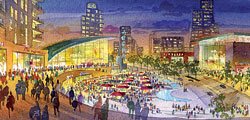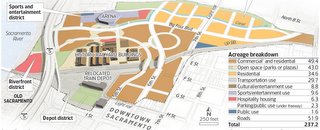
I haven't hit this subject up at all because it's a very frustrating one. As some of you know the railyards is considered one of the largest infill opportunity in the country...and it's been sitting empty for decades.
Millennia, behind some real financial firepower of Stan Thomas and starchitect Jon Jerde, have been negotiating to purchase the site for over 3 years now. It seems like over the last year things have really picked up.
Here is the latest news that seems to indication the arena in the railyards idea is back. I'm not sure about this canal idea, seem to generic but very interesting.
I'm not sold on the street layout. I would like to see more of a grid versus winding streets.
Needless to say 10,000 new homes in our city core would be an amazing accomplishment. One thing I will say, like the build out would be 15-20 years, downtown better be fully on it's way or it may never get there.
I do expect Westfield to fight any retail in the railyards that will take away from downtown. Just like when Mills Corp years ago wanted to turn the front 70 acres into an entertainment and retail destination center. Westfeild said they would expand onto K Street if the city turned down the propoals. The city rejected it and rest is still a dilapidated K Street. I don't expect the city to make the same mistake twice.
From what we have heard, the retail in the railyards would be neighborhood serving. This new plan might deviate from that a little though
The big question is...how is the city going to pay for all this?
___________________________________________________________________
City to hear ambitious railyard plan
By Mary Lynne Vellinga -- Bee Staff WriterPublished 2:15 am PST Thursday, March 9, 2006
The developers of downtown Sacramento's 240-acre railyard today will submit a new plan to the city that includes high-rise housing along the river, a 1,000-seat live theater and a new sports arena anchoring an entertainment district.
Representatives of Thomas Enterprises, which has been working for three years to buy the railyard from Union Pacific, said the revised plan incorporates a variety of wishes expressed by local leaders and community members - from a new downtown home for the Kings to an arts venue that could better accommodate some Broadway shows.
"A lot of this is carrying out the mayor's vision for the railyards," said Suheil Totah, vice president of development for Thomas Enterprises Inc.
The group is not, however, offering to pay for these expensive amenities. It is simply making room for them in its plan. It would be up to the community to figure out a way to get them built, something that in the case of the arena has proved elusive.
"At this point, the important thing is to have a vision, have a dream, have a thought," said Richard Lewis, executive producer for the California Musical Theatre, Music Circus and the Broadway Series. He suggested including the theater in the plan.
"Don't ask me about money," Lewis said.
Joe Maloof, whose family owns the Kings, said he hadn't been informed that an arena would be included in the railyard plan. He said the family doesn't have a strong preference for where an arena should go. But he noted that earlier leaders of the railyard development team - which has morphed substantially in the past two years - said they didn't need an arena to make their project work and didn't express any desire to have one.
"I don't know if they just put the arena in there to make the city happy, or if they really want to do it," he said.
"When they buy the land maybe we'll have a little more excitement," Maloof added, referring to the group's lengthy effort to consummate a purchase of the railyard from Union Pacific.
The railyard plan is ambitious and long range. If the site's prospective owners are able to start construction by April 2007, as they hope, it would still take at least 15 years to build out, Totah predicted.
The plan also has 10,000 housing units, including high-rise towers of up to 40 stories, 3 million square feet of office space and 1.3 million square feet of retail.
Picturesque but dilapidated old railroad shops would become a museum of railroad technology and a public market similar to San Francisco's Ferry Building.
The development would be divided into districts with distinct identities. The Canal District, for instance, would feature a man-made canal curving through a residential neighborhood with shops on the ground floor.
"This is going to be a regional destination, a project of national significance, that people are going to write about for decades," Totah said.
City Manager Ray Kerridge called the plan "very visionary."
"It's exactly what we need in the city of Sacramento," he said. "The stuff they've got in there, the amenities, it seems to hit all the things we need to convert this city to a 24-7, thriving downtown."
The railyard is considered one of the nation's most significant downtown "infill" sites. Just north of downtown, it is about the same size as the existing central business district.
But the site has proved difficult to develop, in part because of its lack of streets and other infrastructure, and because it was so soaked with toxic leftovers from the rail industry that it was labeled a Superfund site.
In 2002, yard owner Union Pacific announced that it had chosen Millennia Associates, led by renowned architect Jon Jerde, to develop about 70 acres. The group later decided it wanted to buy the entire 240 acres.
During the more than three years it has taken to negotiate a sale, Jerde and others associated with Millennia have receded into the background while Stan Thomas, their financial partner, has stepped to the fore. Totah said Jerde remains involved as master plan architect for the project and retains an equity stake.
Mayor Heather Fargo and other city leaders have at times puzzled over just who was in charge. "It was murky," Fargo said. "It was difficult to tell who was representing whom. It seems more clear to me now that Stan Thomas is the man in charge."
Based in Georgia, Thomas has been a shopping center developer in the South for more than 20 years. In the past five years or so he has branched out nationwide into larger, mixed-use projects around the country, said spokeswoman Deborah Pacyna.
Thomas Enterprises now has about 50 people working on the railyard effort. This week, the team moved into new offices next to the railyard in the newly renovated Railway Express Agency Building, where the tall, multi-paned windows look out on historic shops where train cars were once built.
Totah said the agreement to buy the UP land awaits only minor tweaking relating to an insurance policy needed to cover unexpected toxic cleanup costs.
"People think there are issues with the railroad and there are not," Totah said. "It just takes time, and we want to do it right. This is probably the most complicated land deal in the country."
Fargo said she's more confident than she has been in the past that the deal will happen. About three weeks ago, she said, she and Kerridge met with Thomas and bluntly asked him if his plan was "real."
"We had a nice, hopefully honest, conversation," she said. "We think it's real."
One issue that needs to be solved before development can occur is how to come up with $20 million for moving the train tracks several hundred feet to the north - a move that UP says will improve railroad operations. Fargo said the city is negotiating with Thomas' group and UP over potentially sharing the cost.
"It's an impediment right now, and we haven't been able to convince either Union Pacific or Thomas Enterprises to get it done," Fargo said. "They're willing to move it, they're just not willing to write the check yet."






2 comments:
The article and map that appeared in the Bee today was very preliminary. Expect changes to the plans shown, they haven't even gone through the City or CEQA review process yet. The arena is not a big surprise, not sure why Maloof is surprised... better to appear suprised in the press I suppose.
A major question will be how to move traffic to and from the arena without a new interchange. Major expansion of the Richards Blvd interchange would be needed, but that would be the minimum enhancement needed. Certainly the City will be counting on increased transit services, with the new DNA light rail line expansion etc, to serve the new neighborhoods & commercial uses.
The canal is an interesting feature. It would be nice to see the greenway along the canal extended to the riverfront to provide some ped-bike connectivity. The 5th and 6th Street extensions are certainly perplexing... it looks like 6th Street would be really wide and possibly fly over, and the circular street shown between "Big Four Blvd" and the relocated UPRR tracks is confusing, not sure how this jives with 6th St - at grade or elevated?
Not much info on the "riverfront district" and what "hospitality housing" is supposed to be. Hotel? confererence center oriented?
On the price-tag issue -- we've seen a lot of reports lately about the City being asked to cough up subsidies... 926 J Street, the performing arts center on 14th & H, K Street.... hundreds of millions in funding requests. The private sector, I'm afraid, is going to have to invest heavily to make any of this worthwhile. Railyards developers stand to make a killing on this project once fully built, so there is going to have to be some sort of infrastructure financing plan that incorporates impact fees, increment financing, etc.
-Erik
Excellent info, Erik.
I totally forgot about transit. That is going to be a must. The thought of having to drive to the railyards versus jumping on lightrail a block from my house and riding over would piss me off.
Since the "hospitality housing" is so close to the arena, I would imagine that would be a hotel
Post a Comment